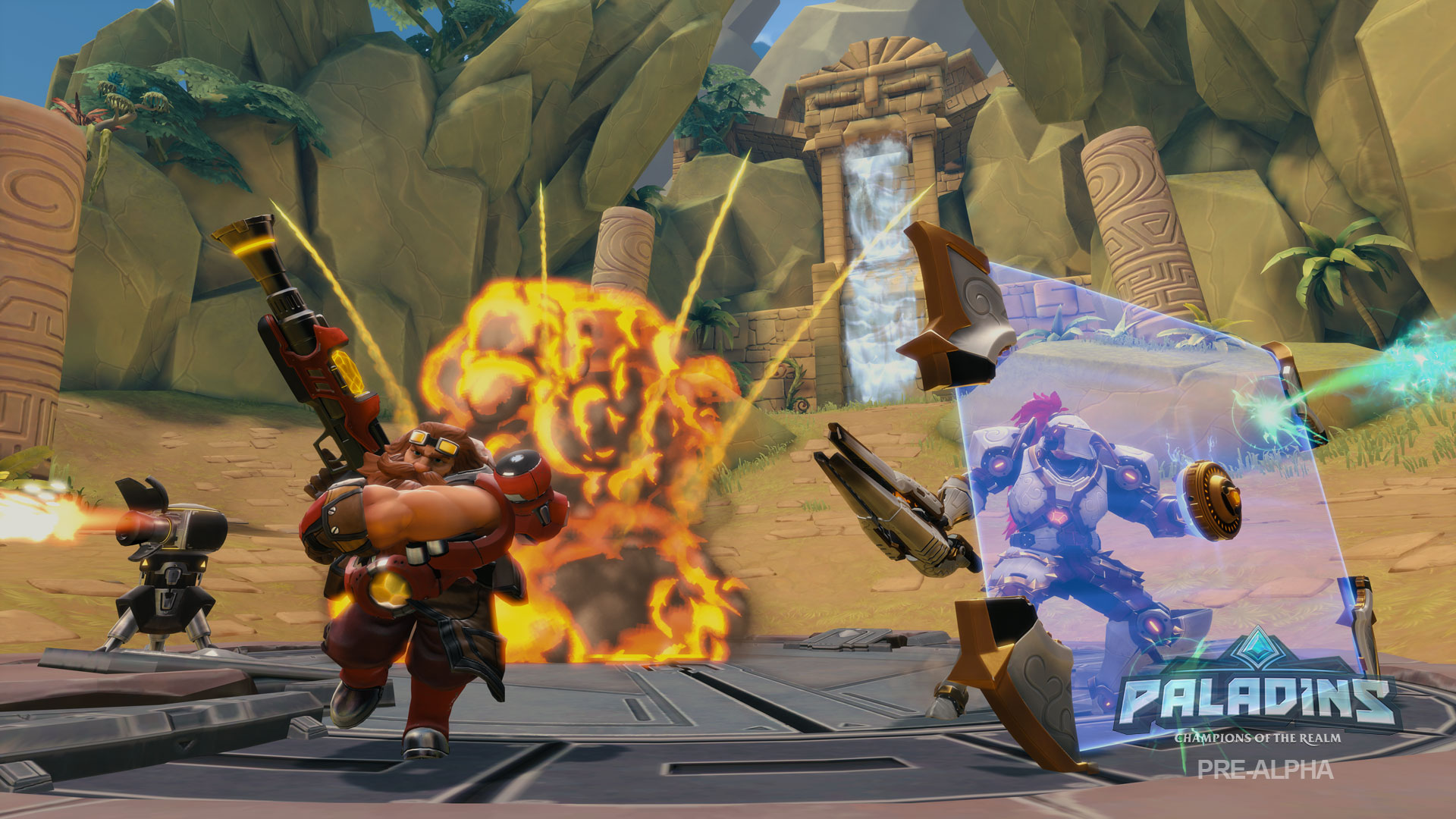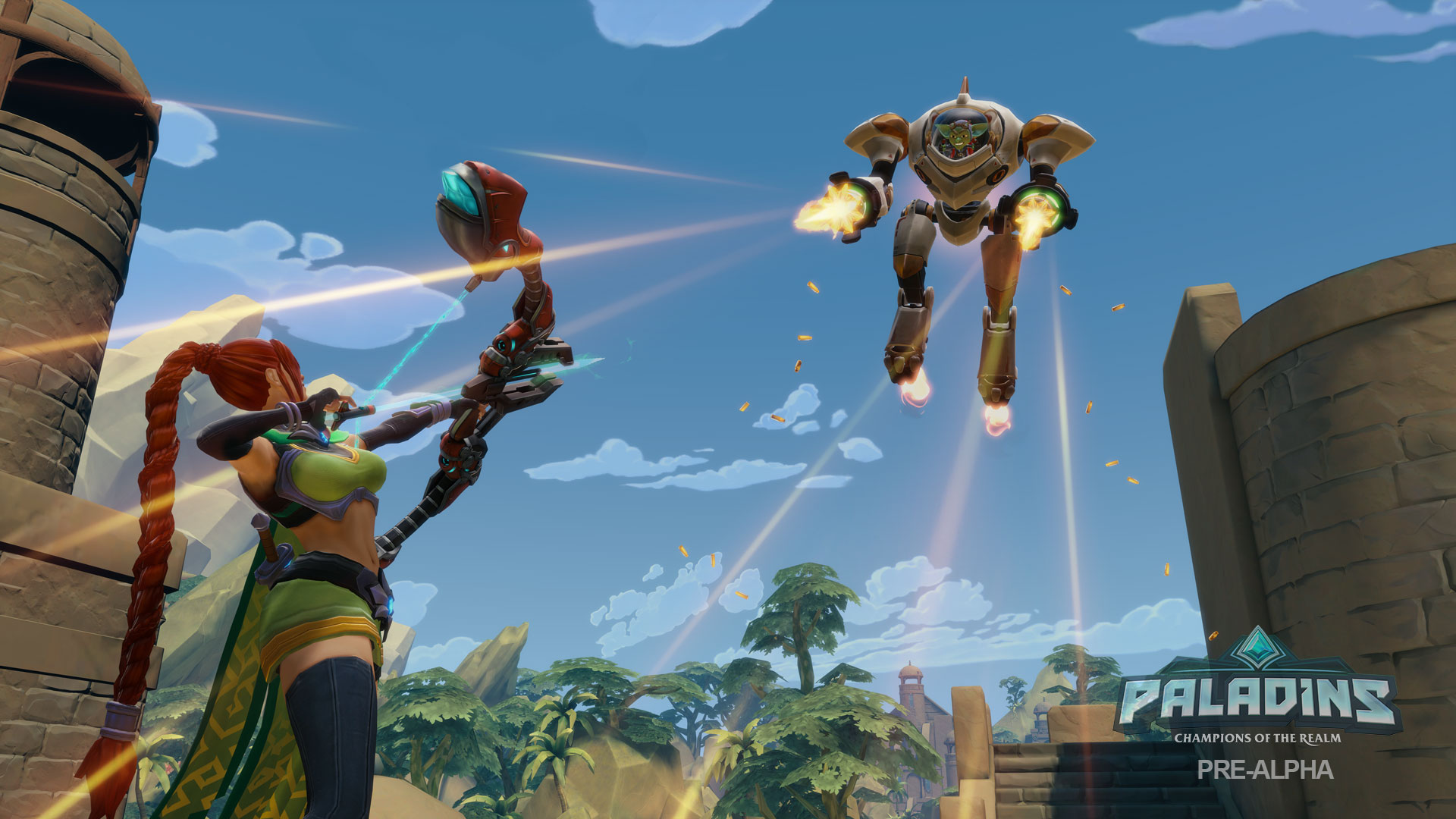
On paper, Paladins feels like Hi-Rez Studios pinned today’s most popular video game buzzwords to a dart board and started throwing. It’s a free-to-play, team-based FPS where each character has MOBA-like abilities and a custom card deck that you build by opening card packs—all wrapped up with a cartoony, fantasy/sci-fi art style. Paladins packs this all into a shooter that’s fun and unique, but is currently a bit repetitive, with weapons that lack the satisfying feedback I’ve come to expect from a shooter.
Paladins does feel like an FPS more than anything else, though, and Hi-Rez president Stewart Chisam was quick to tell me that “it’s a shooter first.” Firing is mostly done from the hip, and every character has a unique weapon, two combat abilities, and a movement ability—usually a dash or dodge. The first character I played, a lightning shaman named Grohk, spat lightning that chained to nearby enemies. My second character, a goblin named Ruckus piloting a possessed mech suit, could hover high above other characters while firing a minigun he never needed to reload. Even though the characters and their abilities leveled up throughout a match, it nearly always felt like good aim and effective strafing could still give me the upper hand against a higher level enemy.
The five-on-five format suits Paladins' competitive focus, a more appropriate scale than the large team sizes of Team Fortress 2 or Dirty Bomb. Your team has to destroy your opponent’s base by capturing control points in the center of the map. Each time your character levels up, instead of assigning ability points, you’re given a choice between three random cards drawn from a 10-15 card deck you build before the match. The cards permanently buff your character with effects like increasing attack speed, decreasing cooldowns, upgrading your abilities, and more—and the later in a match you pick a card, the stronger the effect will be. Respawn timers are short, but your card bonuses will go on cooldown every time you die, leaving you weaker at the beginning of a life.
The card system is unique, but what really makes Paladins feel different from games like it is its pacing. It’s closer to set of tennis than a soccer match, though with far more bullets and explosions than either. Combat is almost always about attacking or defending a stationary point with your team, rather than smaller one-on-one engagements spread out across the map. Only one of three capture points is active at a time, so every player rushes to that spot. When the point is captured, a siege engine is spawned and heads toward the enemy base. A base can only be damaged while a siege engine is present, and the siege engine takes significantly less damage until it starts attacking so, once again, every player rushes to where the two will meet and fights. When the siege engine is blown up, a new capture point activates and the process starts over until one team’s base is destroyed.
“There are actually like 50 different ways to do deck building in a game like this, and we know because we’ve tried all 50.”
Adding deck building to an FPS seems like an awkward fit, but it works surprisingly well—and Chisam told me that’s partially because of how many iterations the card system has been through. “There are actually like 50 different ways to do deck building in a game like this,” Chisam said, “and we know, because we’ve tried all 50.” The cards can give you powerful buffs, but never feel like they are undermining mechanical skills like aim and positioning. Unfortunately, many of Paladins’ current cards have purely stat-based effects, so level-ups have a less noticeable effect than in other ability-based games.
The king-of-the-hill-style fights were fun, but the shooting itself lacked excitement. Each character’s weapons are unique and well-animated, but I didn’t get much feedback that I was hitting an enemy apart from the small red damage numbers spraying from their character. When I activated Grohk’s Chain Lightning ability, I could see damage indicators spouting from the cluster of enemies I was shooting at, but their health dwindled so slowly that it didn’t feel very powerful. Likewise, getting hit didn’t disrupt my actions very much, causing me to not realize how low my health had gotten on multiple occasions.

Additionally, the control point/siege engine/control point loop started feeling routine by the end of my first match, but thankfully the short 10-20 minute match times work in Paladins’ favor. Picking cards forced me to think critically during a match (do I choose the Chronos card at level one to make my ability cooldowns refresh 20% faster, or wait and hope I see it again later when it could potentially make them refresh 100% faster?) but those choices didn’t manifest themselves on the battlefield as much as I had expected. That being said, I wasn’t able to build my own deck and didn’t get a look at the out-of-match progression, so it’s definitely possible I would be more invested if I had gotten a chance to tinker with different strategies.
Keep up to date with the most important stories and the best deals, as picked by the PC Gamer team.
Paladins is currently getting ready for a ‘closed alpha’ launch, and Chisam told me they aren’t anywhere near done creating and balancing all of the cards they want in the final game. Hi-Rez has managed to take a lot of different ideas and mesh them together into a fun and unique FPS—but if Paladins is meant to be a shooter first, then I hope Hi-Rez can spend the alpha period giving the shooting a bit more substance.
You can learn more about Paladins on its official site.
[Update: This article originally listed the Chronos card as giving 20-100% cooldown reduction, when it actually gives 20-100% faster cooldown refresh rates. I have corrected the text, as 100% cooldown reduction would be ludicrous.]


